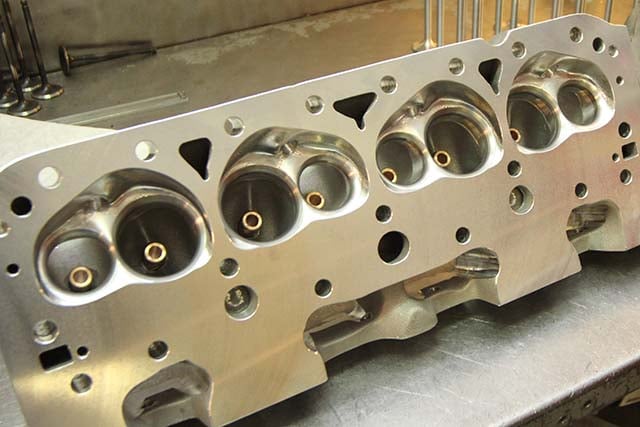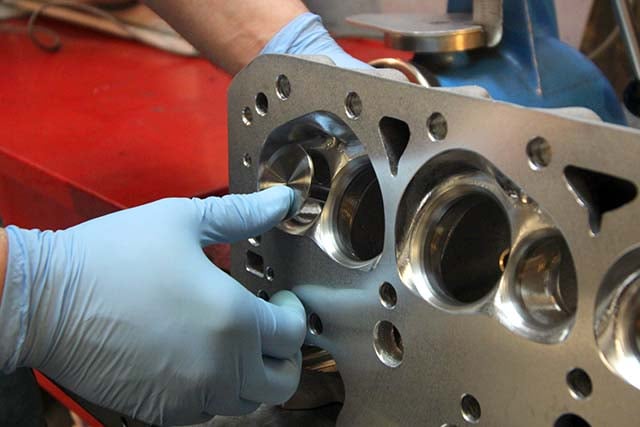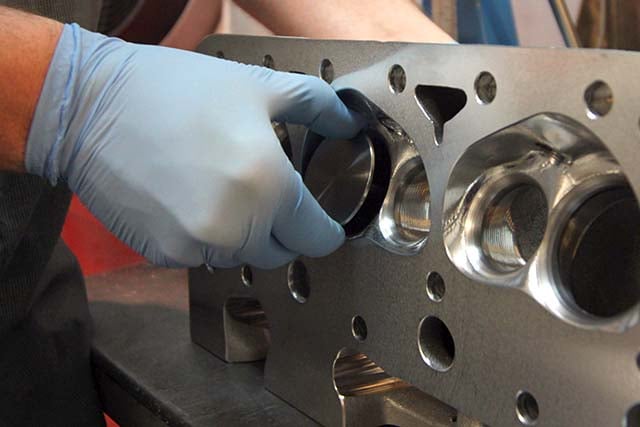
There is a lot you can do as an engine builder without expensive measuring equipment. Here’s how to check the quality of your valve guides and seats.
At Power and Performance News, we’re all about helping you do more for yourself. And the more you can do for yourself when tearing down or rebuilding your next engine, the less you have to spend at your local machine shop.
For example, there are a couple quick checks you can do to verify whether the valve guides and seats are still in good condition. The test doesn’t actually measure guide clearance, but it will give you a good idea if you need to take your heads to an engine machinist to have them worked over.
Now, this isn’t simply something we made up ourselves. While at the shops of KT Engine Development covering some engine builds, cylinder head specialist Kevin Troutman showed us this insider’s trick for quickly determining how much effort a used set of heads may require to bring back up to spec.
Valve Guides
The clearance between the valve stem and the guide in the head is a critical dimension. Too tight and the valve can stick in the guide when the engine gets hot. Too loose and the guide can hold the valve exactly perpendicular to the seat, and both the head of the valve and the seat get beat up. Troutman says that for a standard wet sump engine that isn’t spraying oil in the valvesprings, he normally like to see the valve guide clearance to be between 0.0015 and 0.002 of an inch for standard 11/32 inch valvestems. This is for both iron and aluminum heads.
As the valvestems get smaller you can also tighten up the clearances. For 5/16-inch diameter stems Troutman says he’ll normally tighten things up to between 0.0012 and 0.0015 of an inch. For full-race Nationwide or ARCA race engines that utilize skinny seven millimeter stems, spring oilers and high-end materials he’ll go as tight as 0.0008, but that’s the limit. “You want to be as accurate as you can with your clearances,” he adds, “but if you are going to err, I prefer to do it on the big side. After all, an engine with loose clearances still runs a lot better than one that’s running on seven cylinders because you stuck a valve.”
If you want to check the valve guide clearance on a cylinder head during a teardown–or if you want to check after your machinist after he’s returned a freshly redone head–insert the clean stem most of the way into the head but leave enough room that you can still hold the valve. Some people instert the valve backwards from the top of the head to make it easier. If you have the correct amount of clearance, the valve should have just a small bit of wiggle. No wiggle means you are too tight. That’s the easy part; the hard part is learning how to tell just how much wiggle is too much. The solution for this is to add a coating of light motor oil to the valvestem and repeat the process. This time around if the clearance is tight enough the motor oil should fill that small space and make it feel like the wiggle is all gone. If you still can feel the valve wiggle inside the guide after adding motor oil, it is probably too loose.
Seats

If the seats are worn, they will have a tendency to “grab” the valve. If the seat is good, a valve will bounce off of it.
If the guides are good, the next step is to check the cylinder head’s valve seats. A good-quality seat is flat (not wavy around the circumference) and perpendicular to the valve guide. If the seat doesn’t meet these two criteria it won’t seal well, which means you are losing compression and potential power. When you have a quality seat, the valve will contact the seat all the way around at the same time as it closes.
When the seat is good and contacts the valve all the way around at the same time, the valve will “bounce” back if a spring isn’t installed. So to test the seat, take a new valve–or one that you are certain is good–install it in the guide, give it a good push and see if it bounces back off the seat. A bad seat tends to damp the action, so the valve will feel like it sticks in the seat.
We know this is hard to visualize, so we asked Troutman to demonstrate the valve seat test for us. Check it out in the video below.
So there you have it, a couple of quick and easy checks you can do yourself without any expensive measuring equipment to determine the seat and guide condition on practically any set of heads. These tests are useful when tearing down an engine for a rebuild, checking out a used set of heads you may be considering as a purchase or simply checking after your engine machinist.
And just for fun, we thought we also show this outtake from our video shoot at KT Engines. Sometimes we tend to make things look too easy, so we wanted to show you we’re all human too. Troutman is no rookie; he has done the valve bounce test probably thousands of times. But somehow things are always just a little bit different when the video camera is on, and here’s proof. Even the best of us can have an “oops” moment every once in a while.
Sources
KT Engine Development
384 Industrial Ct
Concord, NC 28025
(704) 784-2610

















